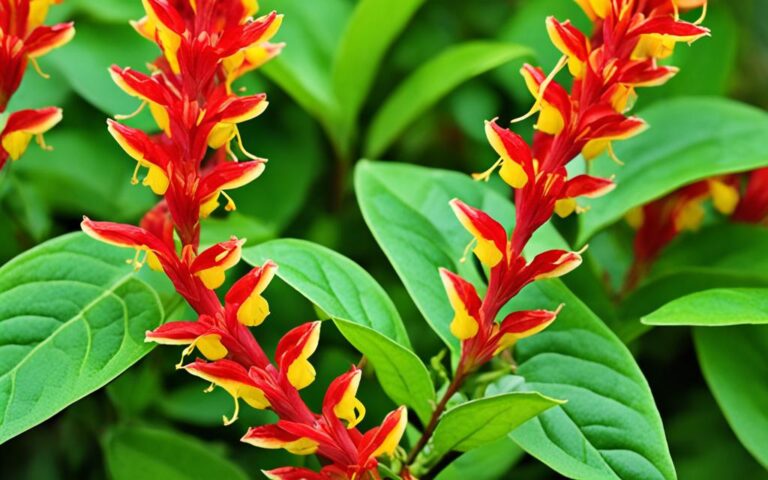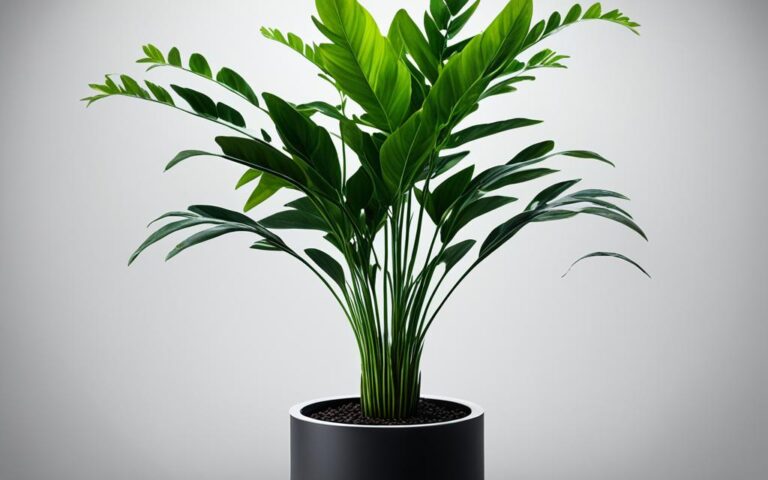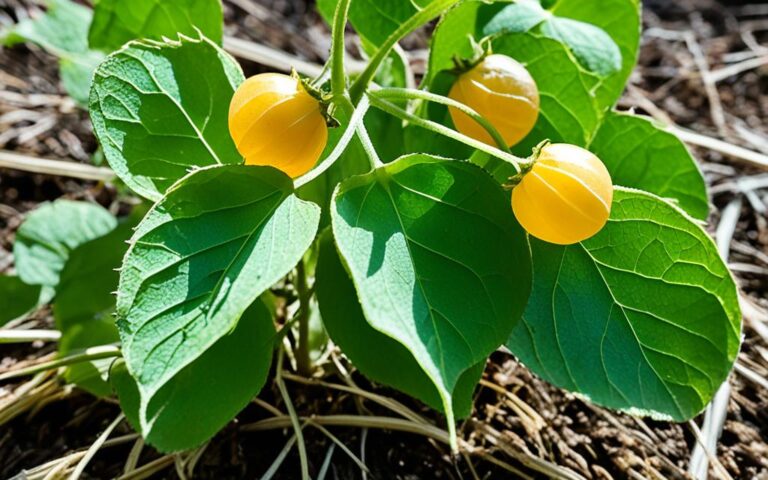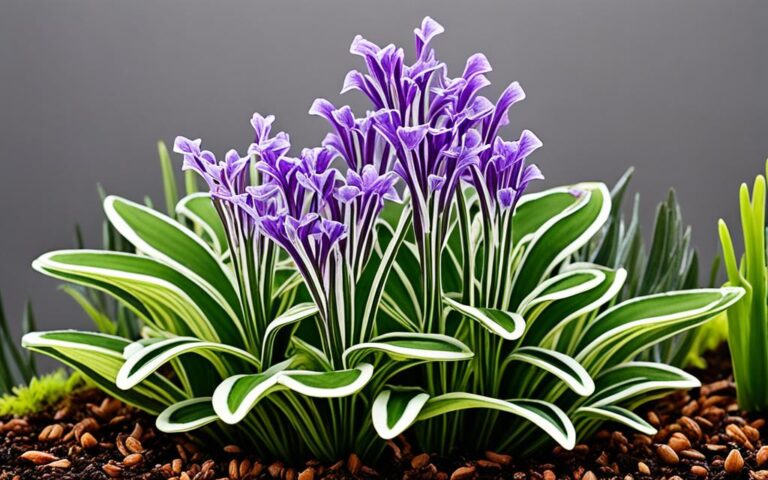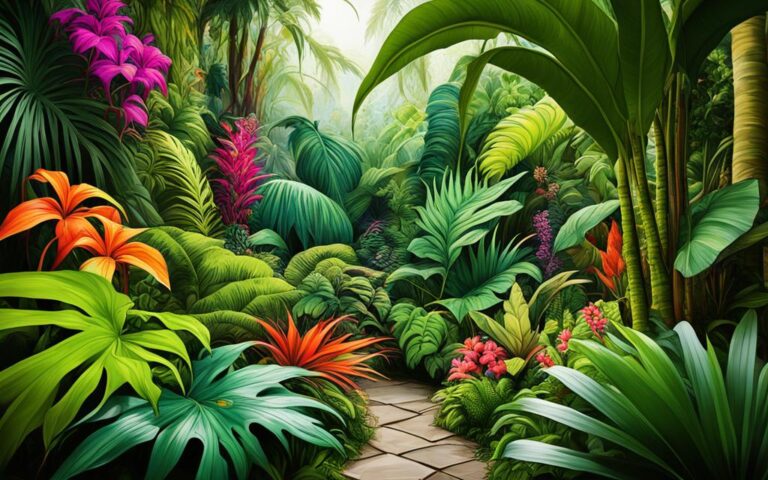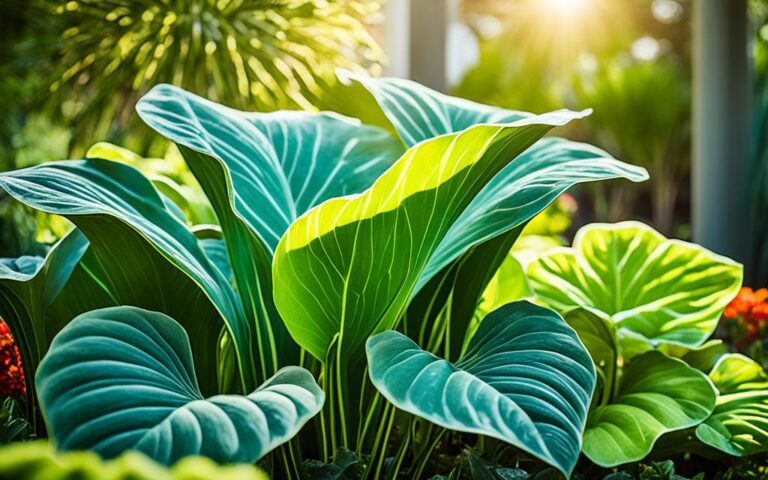Butterfly Plants: Attract Pollinators to Your Garden
Even a small backyard can become a haven for bees, butterflies, and hummingbirds with the right plants. Over 50 species of Penstemon in the Pacific Northwest attract many pollinators. By adding annual and perennial flowers that bloom from spring to fall, you can make your garden a pollinator-friendly oasis.
Key Takeaways
- Bees, butterflies, and hummingbirds are attracted to a variety of perennial flowers
- Planting a mix of annuals and perennials can extend the blooming season and support pollinators
- Certain plant species, like Rudbeckia and Echinacea, are especially known for attracting beneficial insects
- Butterfly bushes and other nectar-rich plants can transform your garden into a pollinator haven
- Choosing the right plants is key to creating a thriving pollinator-friendly garden
The Importance of Attracting Pollinators
Pollinators like bees, butterflies, and hummingbirds are key to healthy gardens and ecosystems. They move pollen, which helps plants grow fruits and seeds. This makes them vital for plant reproduction. By making your garden pollinator-friendly, you help these animals and boost your garden’s health and variety.
How Pollinators Benefit Gardens and Ecosystems
Pollinators need different plants for food and shelter. Adding various plants rich in nectar and pollen attracts and keeps pollinators. This means more fruits and veggies for you and a garden full of colors. Pollinators also help plants reproduce, making your garden more diverse.
Reasons to Create a Pollinator-Friendly Garden
- Support the declining populations of pollinators, such as bees, butterflies, and hummingbirds.
- Increase the productivity and quality of your garden’s produce through improved pollination.
- Enhance the biodiversity and visual appeal of your outdoor space with a diverse array of flowering plants.
- Contribute to the overall health and sustainability of local ecosystems.
Understanding pollinators and creating a garden for them helps conserve these vital creatures. It also keeps your garden vibrant for years to come.
“One out of every three bites of food we eat exists because of animal pollinators like bees, butterflies, and moths, birds and bats, and beetles and other insects.”
Choosing Nectar and Pollen-Rich Plants
Creating a garden that helps pollinators means picking plants full of nectar and pollen. These plants draw in many pollinators and give them the food they need all season. Mixing annual and perennial plants ensures flowers bloom continuously, meeting the needs of different pollinators.
Annual and Perennial Options
Annual flowers like sunflowers, zinnias, and marigolds are full of nectar and pollen in one season. They grow fast and add lots of color to your garden. Perennials come back every year, offering a steady food source for pollinators. Echinacea, lavender, and bee balm are great examples.
Plants That Double as Larval Host Plants
It’s also key to have plants that caterpillars need to grow. These larval host plants help butterflies complete their life cycle. Milkweed is perfect for monarchs, while dill and fennel help swallowtails.
Choosing a mix of nectar, pollen, and host plants makes your garden a pollinator paradise. This helps butterflies, bees, and hummingbirds, and makes your garden healthier and more resilient.
| Plant Type | Examples | Pollinator Benefits |
|---|---|---|
| Nectar-Rich Annuals | Sunflowers, Zinnias, Marigolds | Provide abundant nectar and pollen in a single season |
| Pollen-Rich Perennials | Echinacea, Lavender, Bee Balm | Offer a reliable, long-lasting food source for pollinators |
| Larval Host Plants | Milkweed, Dill, Fennel | Support the entire life cycle of butterflies and moths |
Butterfly plants to Attract Butterflies
If you want to make your garden a haven for butterflies, pick plants they love. These insects prefer flowers with flat tops or clusters and short tubes. They also like bright colors like red, orange, yellow, and pink. These features help butterflies land and get to the nectar easily.
Butterfly-Friendly Flower Colors and Shapes
To draw different butterfly types, mix flower shapes and colors in your garden. Great choices include:
- Marigolds, which attract the Marigold Butterfly when grown in large numbers
- Green-and-white shrubs that attract many butterflies in midsummer
- Purple coneflowers, which draw in butterflies and bees
- Lantana plants, which appeal to butterflies in Zones 4-9
- Black-eyed Susans, which attract butterflies in full sun and well-drained soil
Providing Nectar Sources Throughout the Season
To keep butterflies happy all season, pick a variety of plants with lots of nectar. These should bloom from spring to fall. Some top picks are:
- Anise Hyssop, which attracts butterflies, bees, and hummingbirds in Zones 4-8
- Summersweet shrubs, which bloom after other plants and attract pollinators with their sweet scent
- Mountain mint, which draws in native bees and other pollinators in Zones 5-8
- Rattlesnake master, featuring tiny flower balls that appeal to butterflies in Zones 3-9
With a mix of butterfly-friendly plants, you can make a garden that’s great for pollinators. This will bring a variety of butterfly species to your garden all season.
Plants to Attract Hummingbirds
Hummingbirds make any garden more magical. To draw them in, plant flowers full of nectar. These birds love tubular, brightly colored flowers that are easy to get to. Great choices include agastache, bee balm, fuchsia, and salvia.
Native plants are great for hummingbirds. They’ve grown together over time to offer the perfect food and shelter. These plants give hummingbirds food, shelter, and places to nest all season long.
| Hummingbird Favorite Plants | Key Characteristics |
|---|---|
| Agastache (Hummingbird Mint) | Tubular, brightly colored flowers that bloom repeatedly throughout the season |
| Bee Balm (Monarda) | Showy, nectar-rich blooms in red, pink, purple, and white |
| Fuchsia | Pendant-shaped, brightly colored flowers that are easy for hummingbirds to access |
| Salvia (Sage) | Vibrant, long-blooming flowers in a variety of hues, including red, purple, and blue |
Choose plants with different bloom times for a steady nectar supply. Adding these colorful, nectar-rich plants to your garden will make it a haven for hummingbirds and gardeners.
Plants That Bees Love
Creating a garden that’s good for bees means picking the right plants. These plants are full of pollen and nectar, attracting bees easily.
Flowers With Accessible Pollen and Nectar
Bees like flowers that are easy to get to. Allium, aster, lavender, and zinnia are great for bees. They have lots of pollen and nectar all season long.
Importance of Blue and Purple Blooms
Bees can see blue and purple flowers well. These colors are easy for them to spot in the garden. Geraniums, verbena, and Russian sage are perfect for bees.
Adding bee-friendly plants to your garden helps bees thrive. With cosmos, black-eyed Susans, bee balm, and lavender, you’ll attract bees and support them.
“Gardens serve as green corridors providing habitats for bees and butterflies, ensuring their survival and reproduction.”
Creating a Pollinator-Friendly Habitat
To make your garden a haven for pollinators, it’s not just about flowers. You also need to offer water and places for them to live and nest.
Providing Water Sources
Pollinators like bees and butterflies need water to stay healthy. Add bird baths, shallow pools, or a dripping faucet for them. Make sure the water is clean and changed often to keep it safe.
Offering Shelter and Nesting Sites
Pollinators also need places to rest and hide from danger. Let some parts of your garden be a bit wild. This means keeping dead wood, leaves, or even fake nesting boxes. These spots are perfect for them to live and raise their young.
| Habitat Feature | Benefit to Pollinators |
|---|---|
| Bird Baths and Shallow Pools | Provide a reliable source of clean, fresh water |
| Untidy Garden Patches | Offer shelter and nesting sites |
| Artificial Nesting Boxes | Support diverse pollinator populations |
Adding these things to your garden makes a great place for butterflies, bees, and other pollinators. It meets their many needs.
Organic Gardening Practices
Organic gardening is key to protecting pollinators and making a garden that’s good for the planet. By not using harsh pesticides and synthetic chemicals, we can make a garden that supports many helpful insects. These include butterflies, bees, and ladybirds.
Avoiding Pesticides and Chemicals
Regular pesticides and insecticides can really hurt butterfly populations and other pollinators. They not only harm butterflies and their young but also mess with the garden’s balance. This can hurt insects that eat pests and spiders that keep things in check. To keep your garden safe for pollinators, it’s best to go for organic gardening and avoid these dangerous products.
Ecological Pest Management Methods
- Encourage the presence of predatory insects: Ladybirds, lacewings, and other helpful insects can eat pests like aphids and caterpillars without chemicals.
- Use row covers and physical barriers: These can stop pests from getting to your plants, so you don’t need pesticides.
- Practice manual removal: Check your plants often and remove pests by hand for a pesticide-free gardening way.
- Grow many different plants: A garden with lots of plants can draw in more helpful insects and keep pests from getting too common.
Using these natural pest control ways, you can keep your garden healthy and full of life. You won’t need harmful chemicals to do it.
“Organic gardening is not just about growing food – it’s about growing a healthy ecosystem that supports all life, including the pollinators that are essential for a productive garden.” – Unknown
Backyard Beekeeping
Keeping a beehive in your backyard helps pollinators and lets you enjoy homegrown honey. It takes some special gear and knowledge, but backyard beekeeping is great for gardeners in cities too. With some space, water, and flowers, you can help bees and support pollinators.
To start with beekeeping for beginners, you need a beehive, protective gear, and tools. Picking the right spot for your hive is key. Make sure it’s not too sunny, not in busy areas, and has water nearby.
- Choose a spot that receives partial shade, as direct sunlight can make the hive too hot.
- Ensure the hive is stable and level, with a slight tilt towards the front to help with drainage.
- Provide a steady water source, such as a shallow birdbath or dripping faucet, to keep your bees hydrated.
After setting up your hive, learn the basics of beekeeping. This includes managing the colony, harvesting honey, and keeping the hive healthy. Regular checks, gentle handling, and sustainable practices are important for a healthy hive.
“Beekeeping allows you to play a direct role in supporting essential pollinators and enjoying the sweet rewards of homegrown honey.”
With patience and effort, backyard beekeeping can be a great part of your gardening. It lets you see the world of bees up close and helps your local ecosystem.
Spotlight on Top Pollinator Plants
Creating a garden that’s great for pollinators means picking the right plants. Helenium, yarrow, and agastache are top picks. They help many pollinators.
Helenium (Sneezeweed)
Helenium, or sneezeweed, is a bright perennial with gold, orange, or red flowers and a dark center. It’s perfect for bees and butterflies. It blooms for a long time and grows well in many soils, making it great for any garden.
Yarrow (Achillea)
Yarrow is loved by pollinators because it’s tough and blooms in many colors. From white to pink, red, and yellow, its flowers are easy for bees and butterflies to get to. It’s a favorite for many insects.
Agastache (Hummingbird Mint)
Agastache, or hummingbird mint, is a must for bees and hummingbirds. Its flowers are full of nectar and come in pink, purple, and orange. It blooms for a long time and loves the sun, making it perfect for pollinator gardens.
Adding helenium, yarrow, and agastache to your garden will attract many pollinators. Bees, butterflies, and hummingbirds will love it.
Designing a Pollinator Garden
Creating a pollinator garden means picking the right spot and choosing the right plants. Aim for a sunny area with soil that drains well. This spot will feed these vital creatures all season long.
Choosing the Right Location
Finding the perfect spot for your pollinator garden is crucial. Pick a spot that gets at least six hours of sunlight a day. Stay away from shady or busy areas that might keep pollinators away. Make sure the soil drains well to prevent water damage to your plants and keep pollinators happy.
Incorporating Variety and Succession Planting
For a garden that draws many pollinators, mix different plants that bloom at various times. Use a blend of annuals, perennials, and shrubs for a steady supply of nectar and pollen. With succession planting for pollinators, your garden will look great and help pollinators from spring to fall.
Pollinator garden design is more than making it look good. It’s about building a home that supports our ecosystem’s balance. By picking the right spot and plants, you create a space that helps your garden and the environment.
Maintaining Your Pollinator Garden
Keeping your pollinator garden thriving means regular upkeep. Tasks like pruning and deadheading are key. They help plants bloom more and grow better. Also, overwintering perennials is vital to protect your garden from cold weather.
Pruning and Deadheading
Spending a few minutes each day on pruning and deadheading helps your garden. Pruning keeps plants healthy and looking good. It removes dead or damaged parts and helps new flowers grow. Deadheading makes your garden look better and helps plants make more flowers.
Overwintering Perennials
- Make sure to mulch your perennials to protect their roots from frost.
- Trim dead or dying leaves, but leave some to cover the plant’s base.
- Use burlap or horticultural fleece to cover tender plants from wind and snow.
- Don’t walk on frozen soil to avoid hurting your perennials’ roots.
By taking good care of your pollinator garden, you create a lasting home for bees, butterflies, and other helpful insects. A bit of time and effort keeps your garden full of life for many years.
Benefits of a Pollinator Garden
Creating a pollinator garden is more than just watching bees, butterflies, and hummingbirds. It helps the environment in big ways. By making your garden a home for pollinators, you help keep ecosystems healthy and support the environment.
A key benefit of a pollinator garden is boosting enhancing biodiversity. By planting many types of plants, you make a great place for pollinators. This attracts other helpful insects, birds, and small animals too.
Another big benefit of a pollinator garden is helping your veggies and fruits grow. Pollinators are key to many plants’ ability to reproduce. By giving them food, you help your garden and the whole ecosystem.
A pollinator-friendly garden also helps the environment. With pollinators facing threats like losing their homes and pesticides, your garden can be a safe spot for them. By doing this, you make your garden better and help the environment.
“Pollinators are responsible for the reproduction of over 75% of flowering plants and a third of the food we eat. By creating a pollinator garden, you’re ensuring the long-term viability of these vital organisms and the ecosystems they support.”
In summary, the benefits of a pollinator garden are many. They help with biodiversity, make crops grow better, and support the environment. Turning your garden into a pollinator haven is a great way to help these important creatures. It also helps with conservation efforts that are key to their survival.
Conclusion
Adding butterfly plants and other pollinator-friendly plants to your garden helps bees, butterflies, hummingbirds, and more. By picking a mix of plants with lots of nectar and pollen, offering water and shelter, and using organic gardening, you make a pollinator paradise. This is easy and can change your garden for the better.
This approach not only supports local pollinators but also makes your garden more beautiful and useful. You’ll enjoy the bright colors, lovely smells, and the sight of butterflies and bees. A garden for pollinators is a peaceful spot for people and nature.
As you work on your garden, think about how it makes you and your community happy. The real success of your garden is in the joy it brings, not just the number of species it draws. Let’s all work to make a difference, one garden at a time.

